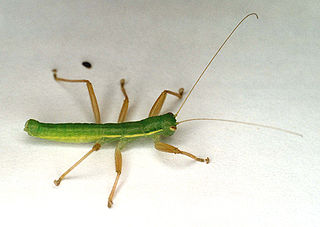
Grylloblattidae, commonly known as the icebugs, or ice crawlers, is a family of extremophile (psychrophile) and wingless insects that live in the cold on top of mountains and the edges of glaciers. They belong, along with Mantophasmatidae, to the order Notoptera. Grylloblattids are wingless insects mostly less than 3 cm long, with a head resembling that of a cockroach, with long antennae and having elongated cerci arising from the tip of their abdomen. They cannot tolerate warmth and many species have small distribution ranges.

Grylloblatta chirurgica is a species of insect in family Grylloblattidae. Like other species in the genus, it is endemic to the United States. This species is also known as the Mount Saint Helens grylloblatid, and is found at high elevations and in ice caves in south-western Washington state, especially in Skamania County around Mount St. Helens. It has also been found in the Chinook Pass area of Yakima County.

Grylloblatta is a genus of insects in the family Grylloblattidae. It contains 15 species, including Grylloblatta chirurgica, almost exclusively from high-altitude and high-latitude regions of the United States, living in ice caves and glaciers.

The wingless insect order Notoptera, a group first proposed in 1915, had been largely unrecognized since its original conception, until resurrected in 2004. As now defined, the order comprises five families, three of them known only from fossils, two known from both fossil and living representatives, and fewer than 60 known species in total.

Edmund Murton Walker was a Canadian entomologist. He described the genus Grylloblatta in 1914 which he then considered as a member of the Orthoptera and later placed it in a separate order Grylloblattodea but which are now included in the order Notoptera.

Grylloblatta campodeiformis, also known as the northern rock crawler, is an omnivorous species of insect in family Grylloblattidae. Like other species in the genus Grylloblatta, it is endemic to North America.
Grylloblatta barberi is a North American species of wingless insect in the genus Grylloblatta. It is a rock crawler that lives at high altitudes in crevices under snow or glaciers. It was first described by Andrew Nelson Caudell in 1924.
Grylloblatta bifratrilecta is a species of rock crawler in the family Grylloblattidae. It is found in North America, including Sonora Pass and Carson Pass in the Sierra Nevada.
Grylloblatta scudderi, also known as Scudder's rock crawler, is a species of Grylloblattidae. It was first described in 1979. It is endemic to British Columbia, Canada, and is unranked by NatureServe as of January 2021.
Galloisiana is a genus of insects in the family Grylloblattidae found in East Asia. It contains 12 species.
Grylloblatta chandleri is a species of insect in the family Grylloblattidae. Its type locality is an ice cave in Eagle Lake in California, United States.
Grylloblatta gurneyi is a species of wingless insect in the family Grylloblattidae. Its type locality is Lava Beds National Monument in northeastern California, United States.
Grylloblatta marmoreus is a species of cave-dwelling insect in the family Grylloblattidae. Its type locality is in the Marble Mountains of California, United States.
Grylloblatta newberryensis is a species of insect in the family Grylloblattidae. It is found in central Oregon, United States.

Grylloblatta oregonensis is a species of insect in the family Grylloblattidae. Its type locality is in Oregon Caves National Monument in the United States.
Grylloblatta rothi is a species of insect in the family Grylloblattidae found in Oregon. Its type locality is Happy Valley in Deschutes County, Oregon, United States. It is also known from Mount Hood and Crater Lake.
Grylloblatta siskiyouensis is a species of insect in the family Grylloblattidae. Its type locality is in Oregon Caves National Monument in the United States.
Grylloblatta washoa is a species of insect in the family Grylloblattidae. Its type locality is Echo Summit in the Sierra Nevada of California, United States. Specimens have also been collected in Placer County and Nevada County.
Namkungia magna is a species of cave-dwelling insect in the family Grylloblattidae. Its type locality is Balgudeok Cave in Jeongseon County, Gangwon Province, South Korea.
Galloisiana notabilis is a species of insect in the family Grylloblattidae that is endemic to southern Japan. Its type locality is Nagasaki Prefecture, Japan.





